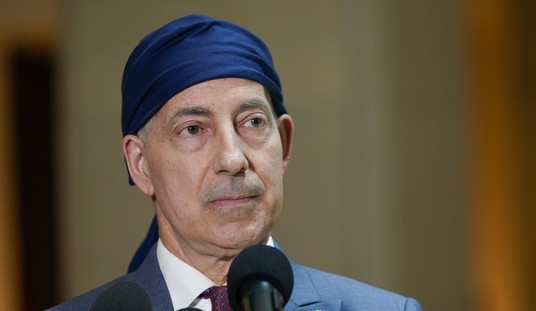
The Seinfeld box set. Kitchen sink, not included.
When DVD was first envisioned, it was primarily as a medium to play back movies. But then the studios discovered something unexpected: people really wanted to relive their favorite TV shows on disc. Today, some of the most memorable moments in television are now nicely packaged in box form. Here’s a very idiosyncratic list of some of the author’s favorites in his collection:
The Prisoner: James Bond, Double-Oh Kafka. Patrick McGoohan’s spy-without-a-name was one of the most adventurous TV shows of the 1960s, an allegory for both the Cold War, and the coming onslaught of political correctness and other forms of Frankfurt School-style reeducation. Killer theme song and brilliant production design to boot.
Monty Python’s Flying Circus: Things began to fall apart in the show’s third and fourth seasons, but for a time, there wasn’t a better working comedy ensemble. Their early episodes, in which sketches ended without punchlines, merged into other sketches, and made references to Kant, Nietzsche, and Descartes (at a time when Norman Lear was slapping himself on the back for getting Archie Bunker’s toilet flush on the air at CBS) were the Citizen Kane of comedic TV. They rewrote the rules, made new ones, and made superstars out of an unlikely assemblage of British television writer-performers, and in the process dynamited postwar British culture (that last item was truly a mixed blessing for England, of course). The 14-disc box set includes its rarely seen episode produced for German television (which took Basil Fawlty’s later advice to not mention the war seriously), along with the Steve Martin-hosted 20 year retrospective, produced shortly before Graham Chapman died, but the real meat of the show are the Pythons’ classic episodes.
The World At War: The great Thames TV documentary, which like Python, became a popular mid-1970s British export to American airwaves, was, in retrospect, made at precisely the right time. There were still enough men alive who had fought on the front lines, along with a fair number of the older generation of generals and politicians on all sides who had prosecuted the war. Film and animation techniques were by the early 1970s sufficiently developed to tell the story graphically. But perhaps most importantly, there was still confidence that the Allies were good guys; moral equivalence, multiculturalism, punitive liberalism, the “black armband school of history,” and all of the other soul-destroying elements of Frankfurt School-style political correctness were not yet standard issue features at the academy, and by extension, the television studio. Oh, and Sir Laurence Olivier is of course pitch-perfect in his stentorian world-weariness. And be on the lookout in later episodes and particularly the bonus features for commentary from a very young, mullet-wearing Stephen Ambrose, 20 years before he became a one-man publishing industry.
Saturday Night Live: Original writer Anne Beatts summed up this show’s arc when she said, “You can only be avant-garde for so long before you become garde.” And SNL, a show that once celebrated youth culture before becoming a corporate institution, is at 35 years old, the very definition of garde. But when SNL first debuted in 1975, it was the logical extension of earlier comedic experiments such as Laugh-In, the leftwing, network-defying Smothers Brothers Show, and the aforementioned Monty Python. Creator/producer Lorne Michaels waged a daily war with NBC’s censors, and for better or worse, imprinted a permanent stamp on the television overculture. The Jimmy Fallon Show’s recent premeditated hit-job on Michele Bachmann would be inconceivable without SNL’s original effort to submarine Gerry Ford via Ron Nessen, his press secretary, and of course, the Daily Show is simply Chevy Chase’s original recurring Weekend Update sketch on steroids.
To get a sense of where network television was in 1975, just rifle through YouTube and watch a clip of The Johnny Carson Show, or one of Dean Martin’s interminable roasts from the period, and you’ll immediately see how exhausted postwar show business culture had become. Saturday Night Live was the Woodstock and Watergate-era counterculture finally getting network exposure, and in the process emerging as the dominant culture in Hollywood, which it arguably remains today. But a curious thing happened along the way: during the original lineup’s run from 1975 to 1980, the politics became toned down, making the show accessible to just about any teenager or young adult in the American heartland who wanted to see a mix of comedy and often deliberately eclectic rock and roll in a single package. The resulting show was the perfect conduit to transmit the products of Big Hollywood, Big Music, and plenty of advertisers’ wares to America’s youth market in the late 1970s. David Brooks’ generation of bourgeois bohemians began here.
The first season DVD box set of SNL, which highlights a show still finding itself, includes the debut episode hosted by George Carlin, the aforementioned appearance by Ron Nessen (and a cameo from Gerry Ford, who never knew what hit him), classic Michael O’Donohue-penned parodies of Citizen Kane and Star Trek, along with the screen tests performed by the cast. Whatever X-factor that John Belushi had that made him an electric performer when the red tally light on the video camera switched on was immediately apparent in his screen test.
Seinfeld: This self-described “Show About Nothing” meant everything to a generation of TV viewers raised on SNL and its first successor, David Letterman. Perhaps that’s why its series finale left such a bad taste in everyone’s mouths. Ever see the movie Trekkies? It’s a human freakshow and 90-minute train wreck, a sort of the documentary version of the way Woody Allen insulted his most rabid fans in Stardust Memories, Allen’s middle finger salute final movie for United Artists. Similarly, Larry David, in terminating the series that made him a very wealthy man, said to his audience, you invested eight years of your life in these pathetic characters? Suckers.
But prior to that, what a ride. I think Thomas Hibbs was spot-on when he included Seinfeld in Shows About Nothing, his trenchant review of the growth of nihilism in television and movies. The characters who inhabit Seinfeld, including Jerry himself – or at least how Seinfeld plays himself as a character in the show’s fictitious universe — really are Nietzsche’s Last Men, as Hibbs wrote. And yet, we love them. To paraphrase James Lileks’ riff about the men of the Mary Tyler Moore Show, every guy who watched Seinfeld wanted to be Jerry, would hate to be George, and knows at least one whacky hipster-doofus type like Kramer. And Elaine, while originally shotgunned into the show by NBC executives (in much the same way they broke up the all-boys club in the original classic first three seasons of Law & Order), was the perfect sidekick for the lads. The box set containing the entire run of Seinfeld also includes scads of interviews, commentaries, trivia, outtakes, and the like. For Seinfeld fans, it’s a total immersion experience, and highly recommended.
Mad Men: If Seinfeld was a show about nothing, then Mad Men is a show about duality. You can see it in Don Draper, brilliant advertising man whose career was built on identity theft; loving family man and serially unfaithful. The show’s characters are a testament to the destructive powers of alcoholism; its first season was sponsored by Jack Daniels. Its pilot episode was on the dangers of smoking, and later, one of its lead characters faces multiple heart attacks; its first season was originally offered in a DVD box set shaped like a cigarette lighter. (It included a coupon inside to purchase a working Mad Men-commemorative Zippo lighter.) Like Don on a bender, Mad Men seemed to lose focus at times during its fourth season. But — and speaking of duality — its original season was both a victory lap for the boomer generation’s ability to tear a culture to its foundation, and a wistful look back at, aesthetically at least, a bygone era of high style.
The Beatles Anthology: Coming at a time when rock & roll was rapidly losing steam – Elvis had been drafted, Jerry Lee Lewis had wrecked his career, Buddy Holly was dead – the Beatles were the ultimate example of lightning in a bottle. The perfect four musicians meet the perfect manager meet the perfect producer. The Beatles Anthology, built around the miniseries that originally aired on ABC – or “A Beatles C” as the network dubbed itself at the time — traces their career in video form from their start to the mid-1990s. Now if only we could get Let It Be released on DVD.
Led Zeppelin: Ever since the late 1970s, Jimmy Page was fond of telling interviewers that he’d like to assemble a chronological live history of his band. He finally did so in 2003, in video form. The first disc of this two-disc set is the band’s concert at the Royal Albert Hall in January of 1970; the second are three of their most important concerts of the 1970s. These include cuts from their 1973 Madison Square Garden shows, later memorialized in their 1976 concert film, The Song Remains the Same, their 1975 performances at London’s Earl’s Court, arguably the peak of the band’s career , and 1979’s two Knebworth concerts, the last of their giant spectacles. The Knebworth section in particular is a revelation, given Jimmy Page’s alleged chemical excesses at the time and their impact on his lead guitar work. By picking the best songs and carefully cleaning up their glitches (click here for my interview with Zeppelin audio engineer Kevin Shirley), the result turned what was a so-so concert into a final triumph — at least on video — for a band rapidly running out of steam.
As I said when we started, this is of course an entirely idiosyncratic list; my personal favorite TV and rock music moments will be very different from yours. So what are your favorite DVD boxed sets? Talk amongst yourself in the comments.









Join the conversation as a VIP Member